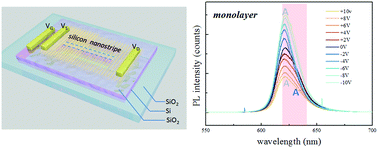Single silicon nanostripe gated suspended monolayer and bilayer WS2 to realize abnormal electro-optical modulation†
Abstract
Transition metal dichalcogenide (TMDC) monolayers or bilayers exhibit exceptional physical properties and unique photoluminescent (PL) features. Plasmonic nanostructures and photonic crystals have been designed to enhance the light–matter interaction and exciton emission of TMDC flakes. Recently, all-dielectric nanostructures with Mie resonances have given rise to a new mechanism in nanophotonics applications. For practical applications, the best case is enhancing the exciton emission and realizing active tuning simultaneously. Here, for the first time, a single silicon (Si) nanostripe, a typical Mie resonator, is used as the gate electrode. PL enhancement and modulation are achieved together in the WS2-Mie resonator hybrid system. Nanoscale Mie-type gating and freestanding WS2 give rise to a new mechanism and a new tuning effect on exciton emission. Changing the carrier density and the tensile strain under gate voltages gives rise to large active tuning on both monolayer and bilayer WS2. Obvious modulation of scattering intensity is also demonstrated, which confirms the distortion of WS2 layers under an electric field. The proposed structure could become a promising alternative optoelectronic device in integrated optics.



 Please wait while we load your content...
Please wait while we load your content...